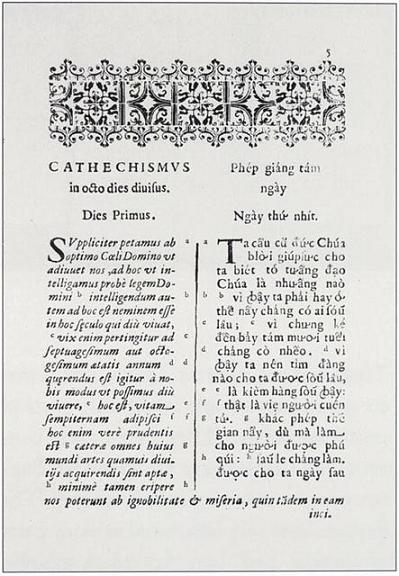Quốc Ngữ
Quốc Ngữ is based on a system devised by Alexander de Rhodes (1591-1660). After arriving in Vietnam in 1719, the French Jesuit missionary compiled a Portuguese-Latin-Vietnamese dictionary, based on earlier dictionaries by the Portuguese Gaspar d'Amaral and Duarte da Costa. Supplanting Chinese and Chữ Nôm, Quốc Ngữ did not become popular until the begining of the 20th century, under French Colonial rule. Its simplicity and phonetic spelling has helped to increase Vietnam's literacy rate to one of the highest in the world (90.3%, according to official figure). Before the adoption of Quốc Ngữ, only about 5% could read or write in Chinese or Chữ Nôm. The increased use of Quốc Ngữ and Western punctuation also coincided with the emergence of Vietnamse prose writing. The first Vietnamese novella, Truyện thầy Lazarô Phiền (Saigon: J. Linage, 1887), was written in Quốc Ngữ by Nguyễn Trọng Quản. Vietnamese writers responsible for developing Quốc Ngữ into a literary medium include Hoàng Ngọc Phách, Phạm Quỳnh, Nguyễn Văn Vĩnh, Phạm Duy Tốn and Hồ Biểu Chánh. The first high school curriculum in Quốc Ngữ did not exist until 1945, when it was established by Hoàng Xuân Hãn, working under the aegis of the Trần Trọng Kim government.
Linh Dinh started this entry.
Quốc Ngữ Fundamentals
The Quốc Ngữ alphabet has 29 letters:
A Ă Â B C D Đ E Ê G H I K L M N O Ô Ơ P Q R S T U Ư V X Y a ă â b c d đ e ê g h i k l m n o ô ơ p q r s t u ư v x y
It also uses 10 digraphs and 1 trigraph:
- CH GH GI KH NG NGH NH PH QU TH TR
It has five diacritic marks, applied to the vowels:
Tone Diacritic Accented Vowels Ngang (Level) Unmarked A/a Ă/ă Â/â E/e Ê/ê I/i O/o Ô/ô Ơ/ơ U/u Ư/ư Y/y Huyền (Falling) Grave À/à Ằ/ằ Ầ/ầ È/è Ề/ề Ì/ì Ò/ò Ồ/ồ Ờ/ờ Ù/ù Ừ/ừ Ỳ/ỳ Sắc (Rising) Acute Á/á Ắ/ắ Ấ/ấ É/é Ế/ế Í/í Ó/ó Ố/ố Ớ/ớ Ú/ú Ứ/ứ Ý/ý Hỏi (Dipping-rising) Hook Ả/ả Ẳ/ẳ Ẩ/ẩ Ẻ/ẻ Ể/ể Ỉ/ỉ Ỏ/ỏ Ổ/ổ Ở/ở Ủ/ủ Ử/ử Ỷ/ỷ Ngã (Rising glottalized) Tilde Ã/ã Ẵ/ẵ Ẫ/ẫ Ẽ/ẽ Ễ/ễ Ĩ/ĩ Õ/õ Ỗ/ỗ Ỡ/ỡ Ũ/ũ Ữ/ữ Ỹ/ỹ Nặng (Falling glottalized) Dot below Ạ/ạ Ặ/ặ Ậ/ậ Ẹ/ẹ Ệ/ệ Ị/ị Ọ/ọ Ộ/ộ Ợ/ợ Ụ/ụ Ự/ự Ỵ/ỵ
Bibliography
- Gregerson, Kenneth J. (1969). A study of Middle Vietnamese phonology. Bulletin de la Société des Etudes Indochinoises, 44, 135-193. (Published version of the author's MA thesis, University of Washington). (Reprinted 1981, Dallas: Summer Institute of Linguistics).
- Haudricourt, André-Georges. (1949). Origine des particularités de l'alphabet vietnamien. Dân Việt-Nam, 3, 61-68.
- Nguyễn, Đặng Liêm. (1970). Vietnamese pronunciation. PALI language texts: Southeast Asia. Honolulu: University of Hawaii Press.
- Nguyễn, Đình-Hoà. (1955). Quốc-ngữ: The modern writing system in Vietnam. Washington, D. C.: Author.
- Nguyễn, Đình-Hoà. (1992). Vietnamese phonology and graphemic borrowings from Chinese: The Book of 3,000 Characters revisited. Mon-Khmer Studies, 20, 163-182.
- Nguyễn, Đình-Hoà. (1996). Vietnamese. In P. T. Daniels, & W. Bright (Eds.), The world's writing systems, (pp. 691-699). New York: Oxford University Press.
- Nguyễn, Đình-Hoà. (1997). Vietnamese: Tiếng Việt không son phấn. Amsterdam: John Benjamins Publishing Company.
- Pham, Andrea Hoa. (2003). Vietnamese tone: A new analysis. Outstanding dissertations in linguistics. New York: Routledge. (Published version of author's 2001 PhD dissertation, University of Florida: Hoa, Pham. Vietnamese tone: Tone is not pitch).
- Thompson, Laurence E. (1991). A Vietnamese reference grammar. Seattle: University of Washington Press. Honolulu: University of Hawaii Press. (Original work published 1965).
Quốc Ngữ online
- Wikipedia's excellent entry
- "Về chữ Quốc ngữ," by Phan Khôi
